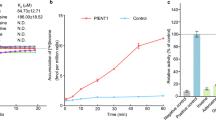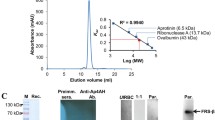Abstract
Among various tropical diseases, malaria is a major life-threatening disease caused by Plasmodium parasite. Plasmodium falciparum is responsible for the deadliest form of malaria, so-called cerebral malaria. Purine nucleoside phosphorylase from P. falciparum is a homohexamer containing single tryptophan residue per subunit that accepts inosine and guanosine but not adenosine for its activity. This enzyme has been exploited as drug target against malaria disease. It is important to draw together significant knowledge about inherent properties of this enzyme which will be helpful in better understanding of this drug target. The enzyme shows disorder to order transition during catalysis. The single tryptophan residue residing in conserved region of transition loop is present in purine nucleoside phosphorylases throughout the Plasmodium genus. This active site loop motif is conserved among nucleoside phosphorylases from apicomplexan parasites. Modification of tryptophan residue by N-bromosuccinamide resulted in complete loss of activity showing its importance in catalysis. Inosine was not able to protect enzyme against N-bromosuccinamide modification. Extrinsic fluorescence studies revealed that tryptophan might not be involved in substrate binding. The tryptophan residue localised in electronegative environment showed collisional and static quenching in the presence of quenchers of different polarities.





Similar content being viewed by others
References
Kicska, G. A., Tyler, P. C., Evans, G. B., Furneaux, R. H., Kim, K., & Schramm, V. L. (2002). Journal of Biological Chemistry, 277, 3219–3225.
Reyes, P., Rathod, P. K., Sanchez, D. J., Mrema, J. E., Rieckmann, K. H., & Heidrich, H. G. (1982). Molecular and Biochemical Parasitology, 5, 275–290.
Hyde, J. E. (2007). Current Drug Targets, 8, 31–47.
Ting, L. M., Shi, W., Lewandowicz, A., Singh, V., Mwakingwe, A., Birck, M. R., et al. (2005). Journal of Biological Chemistry, 280, 9547–9554.
Haider, N., Eschbach, M. L., Dias Sde, S., Gilberger, T. W., Walter, R. D., & Lüersen, K. (2005). Molecular and Biochemical Parasitology, 142, 224–236.
Pegg, A. E. (1988). Cancer Research, 48, 759–774.
Cassera, M. B., Hazleton, K. Z., Merino, E. F., Obaldia, N., III, Ho, M.-C., Murkin, A. S., et al. (2011). PLoS One, 6(11), e26916.
Mao, C., Cook, W. J., Zhou, M., Koszalka, G. W., Krenitsky, T. A., & Ealick, S. E. (1997). Structure, 5, 1373–1383.
Schnick, C., Robien, M. A., Brzozowski, A. M., Dodson, E. J., Murshudov, G. N., Anderson, L., et al. (2005). Acta Crystallographica, D61, 1245–1254.
Madrid, D. C., Ting, L., Waller, K. L., Schramm, V. L., & Kim, K. (2008). Journal of Biological Chemistry, 283, 35899–35906.
Lewandowicz, A., & Schramm, V. L. (2004). Biochemistry, 43, 1458–1468.
Shi, W., Ting, L., Kicska, G. A., Lewandowicz, A., Tyler, P. C., Evans, G. B., et al. (2004). Journal of Biological Chemistry, 279, 18103–18106.
Choudhary, K., Ting, L. M., Kim, K., & Roos, D. S. (2006). Journal of Biological Chemistry, 281, 25652–25658.
Tahirov, T. H., Inagaki, E., Ohshima, N., Kitao, T., Kuroishi, C., Ukita, Y., et al. (2004). Journal of Molecular Biology, 337, 1149–1160.
Chaikuad, A., & Brady, R. L. (2009). BMC Structural Biology, 9, 42–59.
Mardanyan, S., Sharoyan, S., Antonyan, A., Armenyan, A., Cristalii, G., & Lupidi, G. (2001). Biochimica et Biophysica Acta, 1546, 185–195.
Mungala, N., Basus, V. L., & Wang, C. C. (2001). Biochemistry, 40, 4303–4311.
Reshetenyak, Y. K., & Burstein, E. A. (2001). Biophysical Journal, 81, 1710–1734.
Joshi, S., Singh, A. R., Kumar, A., Misra, P. C., Siddiqi, I. M., & Saxena, J. K. (2008). Molecular and Biochemical Parasitology, 160, 32–41.
Bradford, M. (1976). Analytical Biochemistry, 72, 248–254.
Spande, T. F., & Witkop, B. (1967). Methods in Enzymology, 11, 498–506.
Balsera, M., Arellano, J. B., Pazos, F., Devos, D., Valencia, A., & Rivas, J. D. L. (2003). European Journal of Biochemistry, 270, 3916–3927.
Bandivadekar, K. R., & Deshpande, V. V. (1996). Biochemical Journal, 315, 583–587.
Wielgus-Kutrowska, B., Bzowska, A., Tebbe, J., Koellner, G., & Shugar, D. (2002). Biochimica et Biophysica Acta, 1597, 320–334.
Zhang, Z., Ostanin, K., & Van Etten, R. L. (1997). Acta Biochimica Polonica, 44(4), 659–672.
Ponyi, T., Szabo, L., Nagy, T., Orosz, L., Simpson, P. J., Williamson, M. P., et al. (2000). Biochemistry, 39, 985–991.
Church, F. C., Villanueva, G. B., & Griffith, M. J. (1986). Archives of Biochemistry and Biophysics, 246(1), 175–184.
Gunasekaran, K., Ma, B., Ramakrishnan, B., Qasba, P. K., & Nussinov, R. (2003). Biochemistry, 42, 3674–3687.
Laws, W. R., & Contino, P. B. (1992). Methods in Enzymology, 210, 449–463.
Eftink, M. R., & Ghiron, C. A. (1981). Analytical Biochemistry, 114, 199–227.
Mukherjee, S., Saha, B., & Das, A. K. (2009). Biophysical Chemistry, 141, 94–104.
Sultan, N. A. M., Rao, R. N., Nadimpalli, S. K., & Swamy, M. J. (2006). Biochimica et Biophysica Acta, 1760, 1001–1008.
Acknowledgments
We thank the Council of Scientific and Industrial Research, India, for providing junior and senior research fellowships. CDRI communication number: 8443.
Author information
Authors and Affiliations
Corresponding author
Electronic supplementary material
Below is the link to the electronic supplementary material.
ESM 1
(DOCX 25 kb)
Rights and permissions
About this article
Cite this article
Suthar, M.K., Verma, A., Doharey, P.K. et al. Single Tryptophan of Disordered Loop from Plasmodium falciparum Purine Nucleoside Phosphorylase: Involvement in Catalysis and Microenvironment. Appl Biochem Biotechnol 170, 868–879 (2013). https://doi.org/10.1007/s12010-013-0228-9
Received:
Accepted:
Published:
Issue Date:
DOI: https://doi.org/10.1007/s12010-013-0228-9




